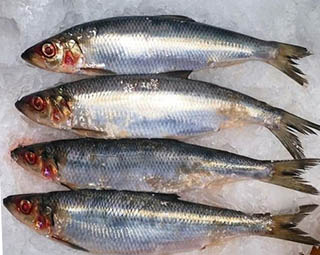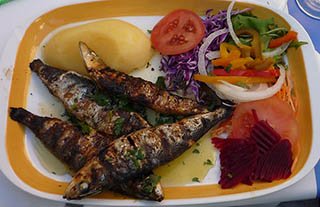Sardines Nutrition facts
Sardines are small, pelagic, cold water-shoaling fish living near coastal areas of the Mediterranean and eastern North Atlantic. Pilchards are actually the same fish, just larger and older adults. Sardines take their name from the Italian island of Sardinia where they were once abundant.
In biology, they belong to the family Clupeidae, which includes other coastal pelagic such as herring and sprat. Anchovies on the other hand belong to the same Clupeiformes order but in the Engraulidae family.
Scientific name: Sardina pilchardus. They also known by many local names as European pilchard, Sardele, Sardina, etc.
 |
| Sardines. |
Description:
Sardines are small pelagic fish that feed on plant diatoms and small crustaceans (zooplankton). The body is sub-cylindrical, belly rather rounded with snouts that overhang a large, lower opening mouth. Their belly is silver gray with distinctive dark spots on their side above the lateral line and the dorsal surface is bluish-green. They typically grow up to 20-25 cm in length and live up to 10-12 years.
Life cycle:
Sardines are indeterminate (fecundity is not fixed before the beginning of the spawning period), and batch spawners (eggs are released in batches over a period throughout the year depending on the region). They prefer cold waters and always spawn in continental shelf shallow waters.
Habitat:
Sardines are oily fish that live near the surface of the sea, congregating in shoals. Their abundance, biomass, and distribution show variations in response to environmental changes. They feed primarily on plant plankton, plankton crustaceans, and fish larvae.
Health Benefits of Sardines
Sardines are marine oil fish; hold 185 calories per 100 g. Its lean meat is a rich source of essential nutrients, protein, micro-minerals, and long-chain omega-3 fatty acids.
Sardine muscles compose good quality protein. 100 g fresh fish holds 20.86 g (37% of DRI) of easily digestible protein that is complete in all essential amino acids.
Sardine muscles and tissues comprise more than 30% fat; particularly long-chain omega-3s like eicosapentaenoic acid (EPA) and docosahexaenoic acid (DHA) present abundantly in them. Research studies suggest that these fatty acids, particularly DHA, play a major function as the building block of our neural system, and therefore particularly important for optimal brain and neurodevelopment in infants and children.
In adults, regular consumption of two servings per week of oily fish has been found to have a beneficial effect on the heart. In the "GISSI Prevention Trial, heart attack survivors who took a 1-gram capsule of omega-3 fats every day for three years were less likely to have a repeat heart attack, stroke, or die of sudden death than those who took a placebo".
Being an oily fish, sardines are a good source of vitamins A, E, and D. 100 g of flesh contains 103 IU of vitamin A. Together with omega 3's, vitamin A is essential for healthy mucosa and skin.
100 g hold 192 IU of vitamin-D; about 48% of daily recommended intake. Vitamin D plays an important role in calcium metabolism and offers protection from cancers.
Sardines contain minimal amounts of mercury. The Food and Drug Administration (FDA) advises pregnant women to consume a weekly serving of seafood ranging from 8 to 12 ounces (approximately 340 grams) that is low in mercury.
Moreover, they are a quintessential source of bone minerals including calcium, phosphorus, and magnesium. In this marine fish, the other trace elements commonly found are selenium and iodine.
| Principle | Nutrient Value | Percent of RDA |
|---|---|---|
| Energy | 185 Kcal | 9% |
| Carbohydrates | 0 g | 0% |
| Protein | 20.86 g | 37% |
| Total Fat | 10.45 g | 51% |
| Cholesterol | 61 mg | 20% |
| Dietary Fiber | 0.5 g | 1% |
| Vitamins | ||
| Folates | 24 μg | 6% |
| Niacin | 4.2 mg | 26% |
| Pyridoxine | 0.143 mg | 11% |
| Riboflavin | 0.233 mg | 18% |
| Thiamin | 0.044 mg | 3.5% |
| Vitamin-A | 103 IU | 3.5% |
| Vitamin-C | 1 mg | <1% |
| Vitamin-D | 192 IU | 48% |
| Vitamin-E | 1.38 mg | 9% | Electrolytes |
| Sodium | 414 mg | 27.5% |
| Potassium | 341 mg | 7.25% |
| Minerals | ||
| Calcium | 240 mg | 24% |
| Iron | 2.3 mg | 29% |
| Magnesium | 34 mg | 8% |
| Phosphorus | 366 mg | 52% |
| Zinc | 1.4 mg | 13% |
| Omega-3 fats | ||
| EPA (20:5 n-3) | 0.532 g | -- |
| DPA (22:5 n-3) | 0.061 g | -- |
| DHA (22:6 n-3) | 0.864 g | -- |
Buying
Sardines perish quickly if not processed and stored adequately. Just like anchovies and other small pelagic fish, fresh sardines are often sold from coastal fishermen who sell them soon after catching them from the ocean.
Sardines are at their best during spring and early summer. Small sardines have the best flavor, but large fish are better for stuffing. Allow 3-5 sardines per serving.
In the supermarkets, they are sold in jars or cans, in the brine, or in tomato/mustard sauce. Processed sardines as a spread (pate), cream, sauce, etc can be readily available in these markets.
At home, store them in the freezer section for extended use.
Dried Sardines
For drying, juvenile sardines are boiled and sun-dried. They are a special delicacy in Japanese (niboshi) and Korean kitchens. For storage, place them in airtight packs and place them in a cool, dry place for a few weeks.
To prepare at home, place fish in baskets and boil salt water for about 15-20 minutes, until the fish floats. Drain and dry them thoroughly under the sun for 2-3 days to remove moisture before storing.
In the West, salt-cured sardines are sold in cans. Once opened, keep the unutilized sardines in the freezer section of the home refrigerator.
Preparation
Juvenile sardines (7 cm long) need little preparation. Scale and gut pilchards (and big sardines) before cooking. Trim the tail end. Cut off the head almost through the spine and twist; gently pull the innards away from the head.
Sardines contain a large number of small bones, which are best removed before cooking. Press down along the backbone. Now again turn over and gently pull the backbone away from the flesh. Bick out any left-over small bones.
Wash in cold water and pat with kitchen paper.
Here are some serving ideas:
 |
| Grilled Sardine with potatoes and other vegetables. Photo credit: Chris |
Just like anchovies, sardines are much sought-after traditional seafood in Portugal, Greece, and Italy.
Being an oily fish, sardines are ideal for grilling, broiling, and barbecuing.
Whole sardines are superbly grilled (broiled) or barbequed, which crisps the skin. They can be coated in breadcrumbs, fried and served with tomato sauce, made into fritters, or stuffed with olives/capers.
In Western Japan, dried infant sardines are known as niboshi or iriko. Niboshi dashi is one of the popular dashi used as the base stock when making miso soup.
Sardines are popular by name as mathi meen in the southern Indian state of Kerala. Mathi meen curry is a popular dish served over rice.
Safety profile
Just like anchovies, sardines too are small, pelagic oily fish. Often polluted coastal water may contain traces of heavy metals and dioxins (Polychlorinated dibenzodioxins (PCDDs)).
Sardines contain small amounts of methyl-mercury- 0.013 PPM. WHO's tolerable upper limit of mercury in food is 0.5 mg/kg of fish. In comparison, tuna holds 0.144 PPM; 9 times more. Accordingly, the U.S FDA final guidelines on how much fish expectant as well as breastfeeding mothers can eat, along with lists of specific options that are safe or should be avoided, place sardines and pilchards in the best choice category. By this yardstick, they can consume 2-3 servings a week. (Medical disclaimer).
Also read ≻≻-
≺≺ Anchovies nutrition facts and health benefits.
≺≺ Atlantic mackerel nutrition facts and health benefits.
≺≺ Salmon fish nutrition facts and health benefits.
≺≺ Back to Seafood from Sardines nutrition facts and health benefits.
Further reading (Links opens in new window):
Omega-3 Fatty Acids: An Essential Contribution.